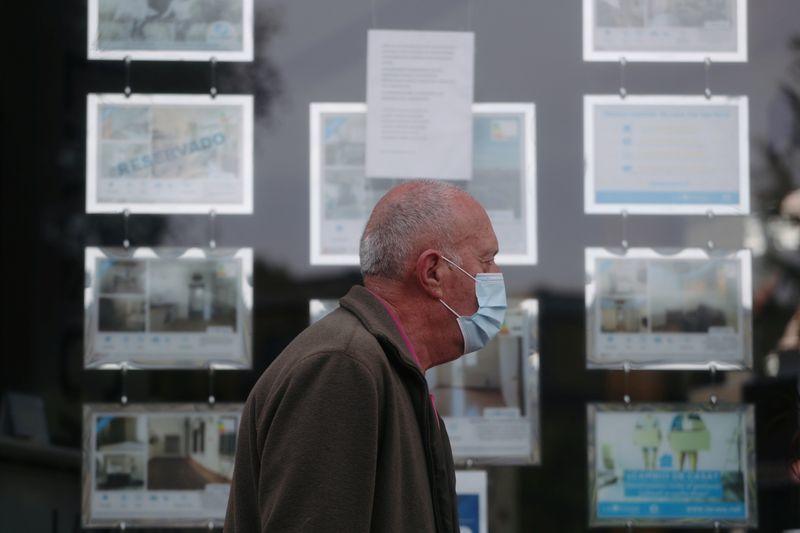Asian markets mostly down as virus fears grow
 With billions of people around the world in lockdown for the foreseeable future, there are increasing worries about the impact on the global economy, which is already expected to fall into recession (AFP Photo/Philip FONG)
With billions of people around the world in lockdown for the foreseeable future, there are increasing worries about the impact on the global economy, which is already expected to fall into recession (AFP Photo/Philip FONG)Asian markets fell Monday following a steep drop on Wall Street as the jubilation from last week’s enormous US stimulus package faded and investors returned their attention to the soaring infection and death rate of the coronavirus.
Donald Trump finally signed off the more than $2 trillion pump-priming measures on Friday, but equities — which enjoyed a rally for much of the week — ended on a negative note as dealers took profits.
While the disease ravages populations and the global economy grinds to a halt with 40 percent of the planet in lockdown, experts are struggling to get a grip on the scale of the crisis that is forecast to cause a worldwide recession.
And analysts say there are likely more dark days ahead, with Trump abandoning his timetable for life returning to normal in the United States and extending emergency restrictions for another month.-
The president said he expected the country to “be well on our way to recovery” by June 1 — dropping his previous target of mid-April.
Meanwhile, senior US scientist Anthony Fauci issued a tentative prediction that COVID-19 could claim up to 200,000 lives in the US.
Governments and central banks have acted to shore up the global economy, pledging around $5 trillion in stimulus support, with China on Monday joining the party by lowering bank borrowing costs and pumping billions of dollars into financial markets, while Singapore also eased rates.
AxiCorp’s Stephen Innes said markets looked like they were “nearing policy fatigue where it becomes less effective, and as the surprise element diminishes, no one cares”.
“So, while policy responses in the US and Europe have been spectacular… the coronavirus keeps spreading globally, deepening fears of the economic and financial impact across countries. More market turmoil likely lies ahead.”
He also pointed out that with the corporate reporting season approaching “now we are about to enter a vortex of bad earnings, bad economic data, and bankruptcies.”
– ‘The big unknown’ –
The downbeat mood weighed on Asian equities, though most pared their morning losses. Tokyo and Hong Kong ended more than one percent down, while Shanghai was off 0.9 percent. Mumbai and Manila lost more than two percent, while Taipei slipped 0.7 percent.
Seoul was flat, while there were also losses in Bangkok and Jakarta.
Singapore slid more than four percent as investors brushed off the city-state’s monetary policy easing measures that came days after data showed it was heading for a deep recession.
However, Sydney soared seven percent in its best one-day performance ever following a more than five percent slide Friday. Traders also were buoyed by data pointing to a slowdown in new infections in Australia as well as an $80 billion economic government support package that was unveiled after markets closed but was widely expected.
In early trade, London and Paris each lost around 2.8 percent while Frankfurt was down 1.6 percent.
“The big question for markets is whether the huge stimulus introduced so far across the globe will be enough to help the global economy withstand the economic shock from the COVID-19 containment measures,” said National Australia Bank’s Rodrigo Catril.
“To answer this question one needs to know the magnitude of the containment measures and for how long they will be implemented. This is the big unknown and it suggests markets are likely to remain volatile until this uncertainty is resolved.”
The return to a risk-averse environment on trading floors also sent the dollar back up against higher-yielding currencies with the Mexican peso, Indonesian rupiah and South Korean won losing more than one percent apiece.
The South African rand plunged more than two percent to a record low after Moody’s slashed its credit rating on the country to below investment grade.
Crude plunged with the market remaining in turmoil, with the Saudi-Russian price war adding to the impact of battered demand caused by the virus. And there are warnings the commodity, already at near two-decade lows, could sink even further as production remains heightened and storage tanks around the world approach full capacity.
“When the storage capacity is filled, we should probably expect a response from Saudi Arabia, Russia, and other essential oil producers,” Innes added, though he warned “the longer their response takes, the higher the risk of another steep decline in oil prices”.
– Key figures around 0810 GMT –
Tokyo – Nikkei 225: DOWN 1.6 percent at 19,084.97 (close)
Hong Kong – Hang Seng: DOWN 1.3 percent at 23,175.11 (close)
Shanghai – Composite: DOWN 0.9 percent at 2,747.21 (close)
London – FTSE 100: DOWN 2.8 percent at 5,358.74
Euro/dollar: DOWN at $1.1073 from $1.1148 at 2100 GMT
Dollar/yen: UP at 108.07 yen from 107.88 yen
Pound/dollar: DOWN at $1.2325 from $1.2450
Euro/pound: UP at 89.80 pence from 89.46 pence
Brent North Sea crude: DOWN 7.8 percent at $22.99 per barrel
West Texas Intermediate: DOWN 5.6 percent at $20.31 per barrel
New York – Dow: DOWN 4.1 percent at 21,636.78 (close)
SOURCE: AFP











